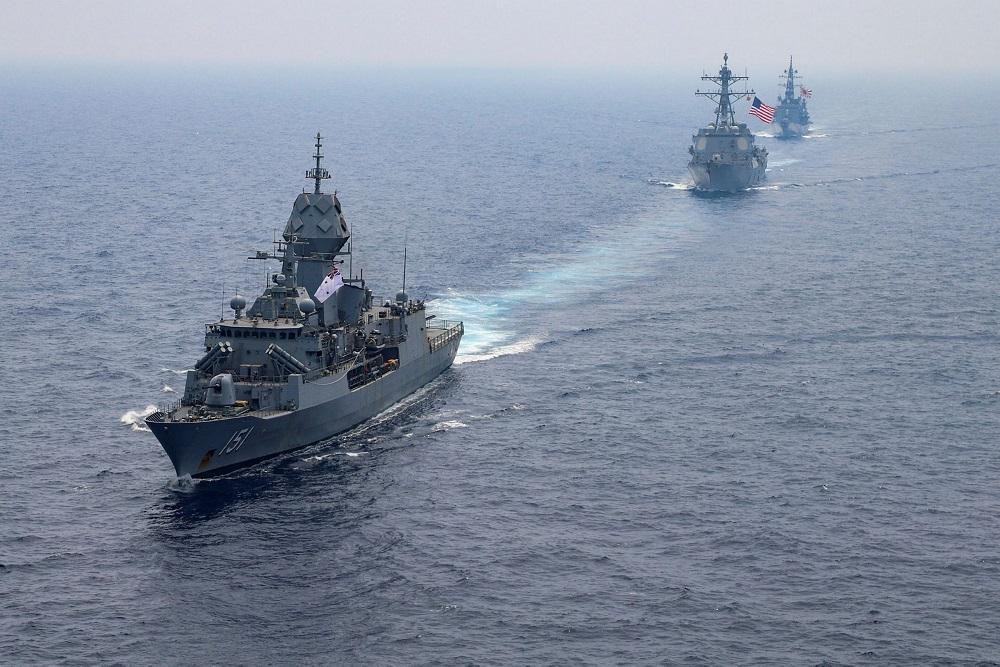
Since its announcement a year ago, the AUKUS agreement linking the US and the UK to Australia’s ambition to acquire nuclear-powered submarines has divided opinion.
Critics have portrayed the pact as an alliance that could destabilise the security architecture of the Indo-Pacific region. The notion is that a proliferation of nuclear-powered submarines could invite a regional arms race and leave the door open to the eventual arming of future Australian subs with nuclear weapons.
One year on, are the critics right in their concerns about AUKUS? This question can be answered only by understanding what AUKUS is, and what it is not, and why this agreement matters beyond its immediate technical provisions.
AUKUS is not a security alliance. It holds no provision to suggest such a notion, nor were any of the steps undertaken so far aimed at making it an alliance.
AUKUS is a technology accelerator agreement for the purpose of national defence, no more, no less. It is designed to allow three countries to work closely together to translate the promise of today’s maturing technologies, such as quantum computing and artificial intelligence, into tomorrow’s military edge.
Last April, the three participating governments said that the implementation of AUKUS would be overseen by senior officials and joint steering group meetings that would define different lines of effort.
These areas would be developed through 17 technical working groups. Nine of them are focused on the submarine program, while eight relate to advanced capabilities. This is not an alliance-building policy process, though the sensitive nature of the technologies in question demands a commitment to sharing highly classified information.
This clarification leads to a second observation. AUKUS is not about achieving stability through a form of deterrence delivered by nuclear-armed submarines.
Rather, the themes in the working groups on advanced capabilities suggest that the main aim of the pact is to elevate the intelligence and deterrent value of conventional capabilities.
In this regard, one of the most striking assumptions about AUKUS is the belief in technology as the key to unlocking the full potential of conventional undersea capabilities through enhanced early warning and, if needed, unmatched targeting precision.
Moreover, AUKUS has revealed how leaders in the three national capitals view the maritime domain as a central pillar to the stability of the Indo-Pacific and the wider international order.
This is why understanding what AUKUS is about matters strategically. It matters because it sheds light on a worldview in which the sea is vital to international affairs and, as a consequence, technology that allows for better operation in, and from, this domain has critical value.
AUKUS’s worldview is one that stems from the recognition that the maritime foundations of the international order stand vulnerable to state coercion. Safe and secure shipping lanes and intact undersea cables are engines fuelling economic prosperity and political stability. This is true in the Indo-Pacific as elsewhere.
The recent Russian blockade of Ukraine’s Black Sea access and China’s military manoeuvres across the Strait of Taiwan are reminders of the risks of disruption to global prosperity at the hands of states willing to exploit the maritime order to exert political pressure.
AUKUS is, therefore, a down payment to prevent one of the most critical components of the international order from being further destabilised.
AUKUS is a statement about why such a specific technology agreement has wider strategic relevance. It does not destabilise regional security because no other piece in the regional architecture is designed to ensure that the sea remains open to business and unchallenged by revisionist states.
Yet, like any investment in future capabilities, AUKUS is likely to change over time. The sensitive nature of the advanced capabilities explored in the collaboration, from submarines to hypersonic missiles, will invite greater proximity and strategic convergence among the partners. The recent news that Australian submariners will train on British boats implies the understanding of such a demand and the willingness to pursue it.
This is the second reason why AUKUS matters strategically. In a context in which advanced technology will matter increasingly more to maintain a military edge, only trusted partners will be able to achieve the most from defence collaborations.
In AUKUS’s case, renewed conversations about cooperation between Australia and France, and among Japan and the AUKUS partners, indicate that AUKUS is not an exclusive club but one with a membership defined by high standards of innovation and information security.
This doesn’t mean that AUKUS won’t face challenges along the way before Australia deploys nuclear-powered submarines in 2040. Implementing the agreement will put national industrial capacity under pressure. Recent comments from senior American officials suggest that the idea of building the initial submarines for Australia in the US could be problematic.
On the other hand, until the propulsion system is chosen, the design and building of the boats remain an open question. When considered against the impact of technology on future changes in systems and sensors, the division of labour is likely to remain a major changing variable.
What is certain is that one year on, AUKUS has started to chart a clear path as to what it is and why it matters. AUKUS is set on a path about a maritime-informed worldview in which accelerating advanced technology cooperation might very well make the difference in how strategic advantages can be secured and maritime stability can be maintained.